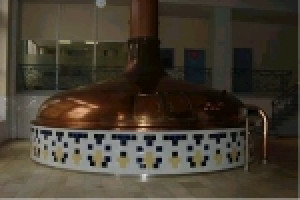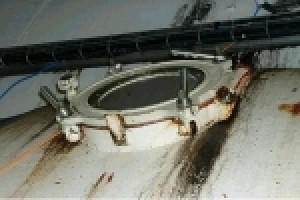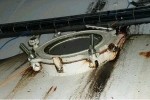In a brewery, the porthole on an 80-m³ beer vat exploded as tank pressure was being increased.
The fermentation process involved 2 phases: a start-up period with atmospheric discharge of the air/carbon dioxide (CO2) mix for 10 to 16 hours, depending on the type of beer; then fermentation with CO2 recovery during a process lasting 8 days. The tanks, operating at 800 mbar, held a volume of 1,040 m³, of which 840 m³ were available and 200 m³ occupied as priming volume by the CO2. Each stage featured 2 pipes fitted with a tap and check valve: an 80-mm pipe for the CO2 atmospheric discharge; the other sized at 105 mm to recover the CO2. This second pipe also contained a by-pass for discharging gas during an incident. The tank outlet was connected to one of the 2 pipes manually and, depending on the state of fermentation progress, via a hose. The 26-cm diameter Plexiglas disc, used here as a sight glass, had been screwed onto a 2.8-m high metal support. During the accident, the tank was operating in the fermentation phase and its vent was positioned towards the CO2 discharge. According to findings, 40 m³ of CO2 dispersed into the atmosphere and a small quantity of beer overflowed into the sewers, reaching the site’s wastewater treatment plant. The facility was evacuated. Notified by the site watchman, fire-fighters ventilated the workshop to allow brewing activities to resume. An investigation determined that the flexible hose had indeed been connected to the tank’s CO2 outlet and moreover the corresponding valve had remained open; however, the check valve (fitting not equipped with a keying device, unscrewed and cleaned for each maintenance) had been installed backwards. Upon bursting, the sight glass served as a rupture disc. As it turned out, the tanks had not been equipped with a relief valve or disc for such an occurrence, nor could they measure pressure automatically.
A number of emergency provisions were adopted, namely: all check valves were verified and marked in order to avoid assembly errors; a memorandum was circulated to employees regarding the incident and its likely causes; and the sight glass was replaced.
A repeat accident of this type, yet with a different source, occurred the next day on another tank.
Download the detailed report in .pdf format (85 Kb)






